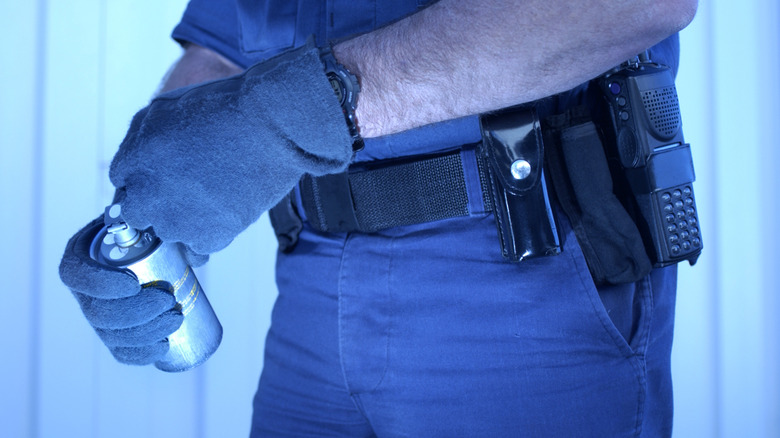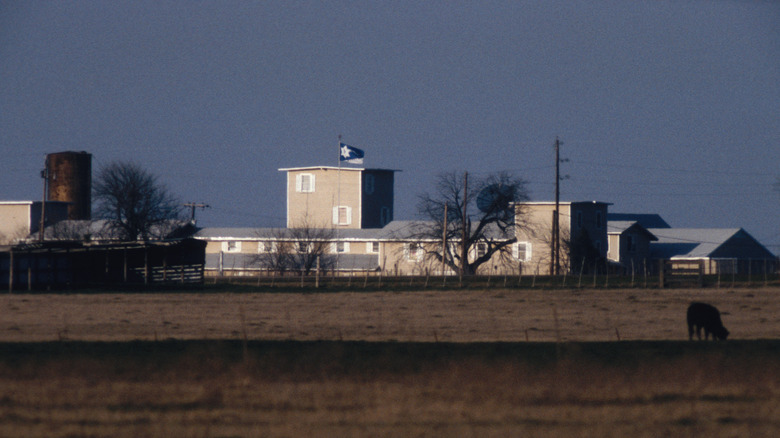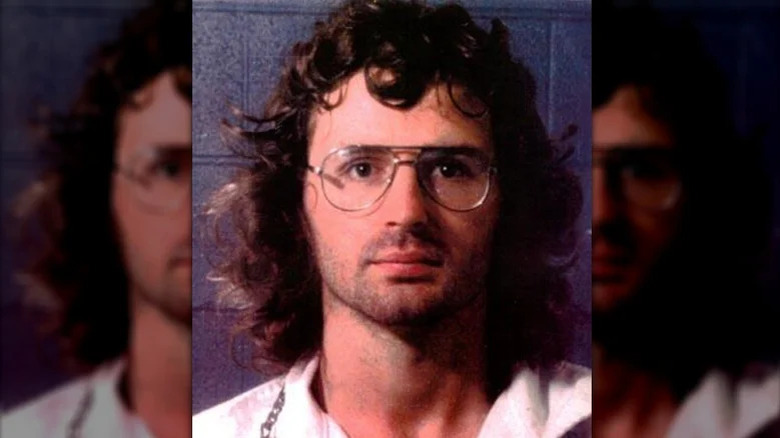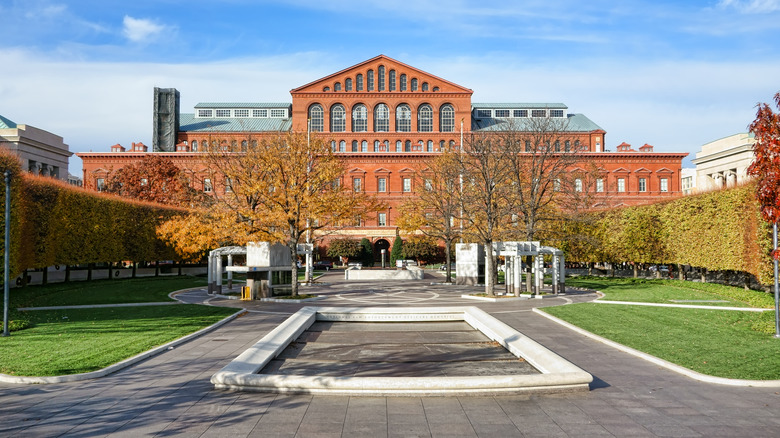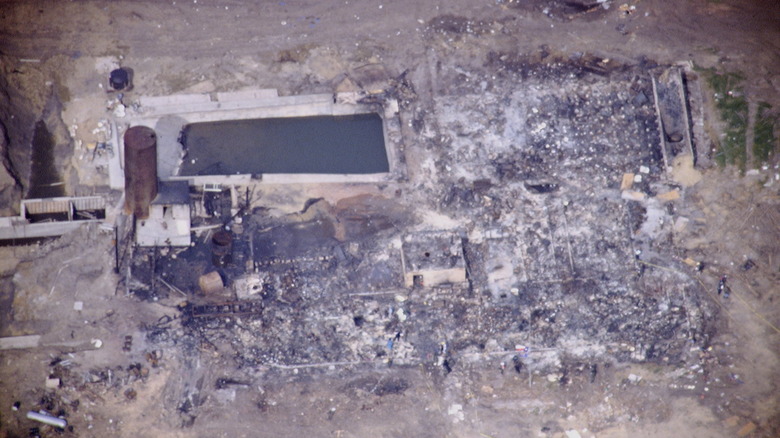What Happened To The Bodies From The Waco Siege?
The 51 days of the infamous Waco siege started on February 28, 1993, when the Federal Bureau of Alcohol, Tobacco, Firearms, and Explosives (ATF) tried to raid the Mount Carmel Center, a compound near Waco, Texas, housing a group called the Branch Davidians. The heavily armed residents and their infamous cult leader David Koresh knew that the ATF was coming, and soon, a gunfight turned into a lengthy siege. Sadly, the aftermath included many corpses, whose fate varied.
The initial confrontation involved 70 ATF agents, but by the end of the siege, there were around 900 representatives of various agencies on site. Negotiations with Koresh proved intense and difficult, and the authorities tried numerous methods of weakening the Branch Davidians' opposition. However, nothing worked, so on April 19, the FBI got the green light to raid Mount Carmel. Branch Davidians responded by setting the building on fire, and by the time the smoke settled, only bodies, a handful of survivors, and many questions about the way the authorities had handled the events remained. What's more, Waco also inspired Timothy McVeigh to commit the Oklahoma City bombing precisely two years after the siege's end.
The vast majority of Branch Davidians died during the events of April 19. Dvmmoms has already told you about all the ways the Waco siege was even worse than you think. Now, let's take a look at what happened to the Branch Davidians after Mount Vernon fell. Here's what happened to the bodies from the Waco siege.
Exactly how many bodies there really were remains unclear
The dramatic and explosive end of the Waco siege meant that David Koresh's Branch Davidians are now considered one of the most dangerous cults in recent history. However, the actual death toll of the siege remains somewhat unclear.
Nine Branch Davidians escaped the fire, and the initial investigation of the Waco siege turned up 72 bodies. However, David Koresh had stated before his death that there were a total of 95 people in the building, but whether Koresh was inflating the numbers or actually telling the truth is uncertain. Assuming his count was correct, this means that 14 bodies were never found in the rubble — a possibility that the investigators accounted for by stating that the raging fire may have completely destroyed some of the human remains.
Because of the chaotic nature of the incident, there's still some uncertainty over just how many Branch Davidians died in the fiery, bloody end of the siege, and it's not uncommon to see prefixes like "at least" and "nearly" in reports and writings of the Waco siege. It's also unclear whether a particular death toll report includes the four ATF agents who died in an earlier gunfight with the cultists. If an outlet gives an exact number of the adults and children who died in the fire, the one you're most likely to see in modern reporting is 75 – but many seem to play it safe by keeping things somewhat vague.
A medical examination concluded that tear gas didn't contribute to the cultists' deaths
The way the authorities handled the Waco situation drew a lot of criticism, even though it was eventually concluded that the Branch Davidian cultists had set the compound on fire themselves. One line of investigation involved the FBI's copious use of 2-chlorobenzylidene malononitrile tear gas, aka CS gas, in an effort to flush the cultists out of the building. Some have suspected that the FBI's hours-long tear gas barrage may have hindered the Branch Davidians' ability to escape the compound once the fire started, and people have also noted that CS gas releases cyanide when exposed to fire.
Despite this, a medical examination of the dead Branch Davidians' remains found that CS gas played no part in their death. Instead, many cultists died from asphyxiation, gunshots — either self-inflicted or from fellow Branch Davidians — or pieces of the crumbling building falling on them.
While the FBI has done some idiotic things, they've been cleared of misdeeds during the Waco siege. Still, even though it may not have directly contributed to the Branch Davidians' deaths or the destructive fire, the FBI's attempt to flush out the cultists with extreme amounts of tear gas was a harrowing experience. "I saw people in the chapel who had short sleeves on trying to rub it off; they were crying," surviving Branch Davidian Clive Doyle testified in court (via The Austin Chronicle). "It was like battery acid on your skin."
Autopsies revealed that the children were shot to death
Even before the Waco siege's ending, it was fairly clear that the Branch Davidian group was a pretty bad place for a child. Allegations of indoctrination and outright child abuse had been made against David Koresh by authorities and survivors alike, and children who made it out of the compound alive before the fire had trouble adjusting to normal life. However, the events of April 19, 1993, took things from bad to worse. Though the cult released many children during the siege before it ended, the bodies of 25 children were found in the aftermath of the compound fire.
When autopsies were performed on 21 bodies of adult and adolescent Branch Davidians who died in the siege, the authorities discovered that they had all died violently — but not from the fire. Instead, 20 of them had been shot to death by fellow cultists. The 21st body was that of a three-year-old, who had been fatally stabbed.
David Koresh's unceremonious end
Cult leader David Koresh died during the events of April 19, 1993, like most other members of the group at the compound. Koresh's badly burned remains were found three days after the fire, but like many other Branch Davidians, he didn't perish from the fire. After his extensively damaged body was identified, an examination found that his body had a bullet hole in the forehead.
The actual details of Koresh's death remain a mystery, but it's worth noting that he was unarmed at the time of his death. The FBI has put forward a theory that Koresh's right-hand man Steve Schneider pulled the trigger on the cult leader, possibly after realizing that Koresh was trying to escape the burning compound and coming to a conclusion that the man he trusted was a fraud. Regardless of what actually happened, Schneider also died from a bullet, and his body and a rifle were found close to Koresh's remains.
After the investigation, Koresh's remains were given to his family, who buried him in an unmarked grave at Memorial Park Cemetery in Tyler, Texas. Only four people were present. According to the Los Angeles Times, however, some relatives suspected that the body they were given might not actually have been Koresh at all. "I don't think I will ever rest in my heart," Koresh's mother, Bonnie Haldeman, said. "I didn't get to see the body, and I'm not even positive that is David there. Who knows?"
The four dead ATF agents were honored and buried
Apart from the Branch Davidians who died in the Waco siege, several government agents also perished. On February 28, 1993, ATF special agents Todd McKeehan, Robert Williams, Conway LeBleu, and Steven Willis died in the initial fierce gunfight between government agents and David Koresh's cult members. Another 28 agents were also injured during the siege.
ATF held a joint memorial for the four fallen agents at the National Law Enforcement Officers Memorial in Washington D.C. on May 23, 1993, and they also have a cenotaph stone at the ATF Mount Carmel Siege Memorial in Texas. As for their actual bodies, they're buried in different locations. McKeehan's grave is at the Happy Valley Memorial Park in Carter County, Tennessee, and Williams' grave is located at the Brandon Memorial Gardens in Rankin County, Mississippi. LeBleu rests in his native Lake Charles, Calcasieu Parish, Louisiana, and while Willis was also born in Louisiana, his final resting place is in Houston, Texas.
Unclaimed Branch Davidian bodies were buried in a mass grave
Apart from David Koresh, some of the Branch Davidians who died in the siege were ultimately claimed and found their final resting place. Notably, 24 of the cultists were from the United Kingdom, and at least some of them — such as Stephen and Phillip Henry — received a proper burial and funeral service on home soil. Unfortunately, the destructive fire meant that some of the bodies simply couldn't be identified. As such, the Henrys' funeral also served as a memorial for their mother and three sisters, who also died at the compound.
Around 30 of the bodies were unidentified or unclaimed by the families. These bodies were kept in storage until late 1994, both because the authorities considered using them as evidence and because some victims' lawyers wanted further tests to determine the cause of death. Ultimately, these victims were buried in pauper's graves not too far from the place they died — at Restland Cemetery in Waco, Texas. In recent years, surviving Branch Davidians and relatives of the dead have started working toward DNA testing and relocating these remains. In 2021, 10 of the pauper's grave bodies — including some of Koresh's closest family members – were moved to the nearby Rosemound Cemetery at the behest of one prominent Branch Davidian's son.
If you or someone you know may be the victim of child abuse, is dealing with spiritual abuse, is struggling or in a crisis, help is available. Contact the relevant resources below:
-
The Childhelp National Child Abuse Hotline at 1-800-4-A-Child (1-800-422-4453) or contact their live chat services.
-
The National Domestic Violence Hotline at 1−800−799−7233. You can also find more information, resources, and support at their website.
-
Call or text 988 or chat 988lifeline.org


